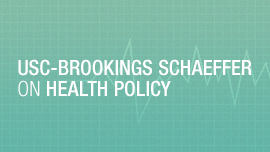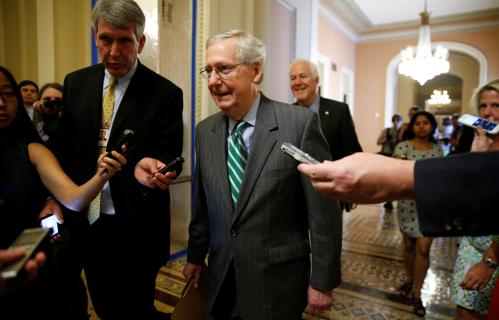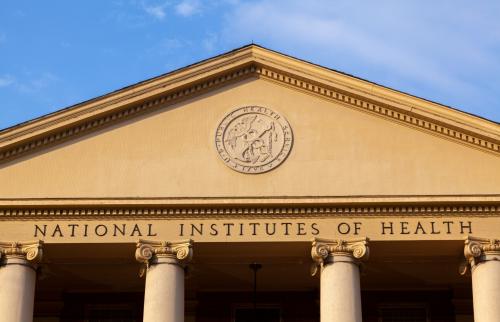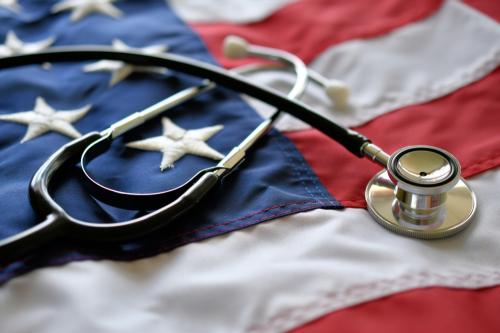This analysis is part of the USC-Brookings Schaeffer Initiative for Health Policy, which is a partnership between the Center for Health Policy at Brookings and the University of Southern California Schaeffer Center for Health Policy & Economics. The Initiative aims to inform the national health care debate with rigorous, evidence-based analysis leading to practical recommendations using the collaborative strengths of USC and Brookings.
Following the failure of several Affordable Care Act (ACA) repeal bills in the Senate, there has been increased interest in designing bipartisan ACA reform legislation, both within the relevant Senate committees and among analysts and policy organizations. Bipartisan packages being developed or proposed seek to stabilize the market through such means as clarifying that cost-sharing reduction payments are appropriated, while also liberalizing the rules around state innovation waivers under section 1332 of the ACA.
We have pointed out before that the ACA’s Section 1332 provides powerful flexibility for state-led health reform. In a series of earlier blog posts, one of us (Levitis) has also raised concerns about section 1332 changes included in the various Senate repeal bills released over the past several months. Some of these changes were substantive and would have undermined the guardrails that prohibit waivers from weakening health coverage or increasing federal deficits. Others were procedural and would have undermined the safeguards that govern waiver review, approval, and revocation.
While these earlier Senate proposals raised serious concerns, Congress has better options to make section 1332 more flexible. In this report, we suggest four legislative changes to the current 1332 language and procedures that we believe could command bipartisan support. These changes would make the state innovation waiver program more useful to states, without many of the downsides of earlier Senate bills. Specifically:
- Liberalize the rules for calculating pass-through funding in a way that permits states to share more of the federal savings their waivers generate, but maintains the guardrails, thereby continuing to disallow waivers that imperil coverage goals or the federal budget.
- Require expedited review for “lookalike” waivers – those that are materially identical to one already approved for another state.
- Require expedited review of emergency waivers designed to address such problems as a public health crisis or an imperiled insurance market.
- Increase the federal staff handling waivers, to reduce delays and to encourage innovative state proposals.
These changes are not without some risk. Section 1332 currently combines broad state flexibility with key safeguards, and some of these changes would shift the balance away from the safeguards to some degree. Nonetheless, through careful design, the risks appear modest and worthwhile, especially in the context of a legislative compromise to eliminate damaging uncertainty about cost-sharing reduction payments and otherwise strengthen insurance markets.
BACKGROUND ON SECTION 1332
Section 1332 provides broad flexibility for states to eliminate or modify many of the ACA’s central coverage provisions, including the health insurance Marketplace, related subsidies, the individual and employer mandates, and certain rules regarding which plans may be offered in the individual market. If a waiver results in a reduction of federal Marketplace subsidies flowing to state residents, the state can receive the difference in “pass-through funding” to implement the state’s own plan for providing coverage.
Section 1332 balances this flexibility with substantive and procedural safeguards to prevent a waiver from harming individuals’ coverage or increasing federal deficits. The substantive safeguards, often referred to as “guardrails,” require that a waiver will not:
- Reduce the number of people with health coverage;
- Reduce the affordability of health coverage;
- Reduce the comprehensiveness of health coverage; or
- Increase the federal deficit.
Section 1332 also includes several procedural safeguards. The Secretary of Health and Human Services and Secretary of the Treasury jointly approve or deny waivers, and they have discretion to deny a waiver even if they find that it satisfies the guardrails. A waiver may be approved for no more than five years (with the possibility of renewal, subject to the same standards). Section 1332 does not specifically address waiver revocation, but the regulations finalized in 2012 provide that a waiver may be revoked if the Secretaries determine that it is not satisfying the requirements – for example, that it is costing more than expected and increasing federal deficits. In addition, before a state can apply for a waiver, it must pass legislation enacting the state’s plan to provide coverage under the waiver – an assurance of broad support within the state.
Together, these safeguards are intended to ensure that the broad flexibility available under waivers does not come at the cost of health coverage, federal budget discipline, or program integrity.
Two waivers have been approved to date under this arrangement. Hawaii waived rules regarding the small group market and received pass-through funding for forgone small business tax credits, beginning in 2017. Alaska waived the single risk pool requirement and created a state reinsurance program to reduce premiums, effective in 2018. The reinsurance program will be funded in part by pass-through funding resulting from the premium reductions under the waiver. Minnesota, Oklahoma, and Oregon have submitted applications for waivers very similar to Alaska’s, also to begin in 2018. The other active waiver applications are one from Massachusetts, which would address uncertainty about cost-sharing reduction payments, and one from Iowa, which would substantially remake the individual market in the state. Several other states have also taken steps towards seeking waivers.
PROPOSAL #1: REMOVE THE DOUBLE CAP ON PASS-THROUGH FUNDING WHILE PRESERVING DEFICIT-NEUTRALITY
Current Law. Pass-through funding under section 1332 is currently subject to two separate caps, each of them separately limiting the amount that can be paid. First, section 1332(a)(3) provides that pass-through funding is generally equal to the amount of federal marketplace subsidies (tax credits and cost-sharing reduction payments) that would be made absent the waiver but that is forgone under the waiver. For example, if a waiver would reduce premiums and thereby reduce premium tax credit payments to state residents by $10 million in a year, then the state can generally receive $10 million in pass-through funding for that year. The second constraint results from the requirement in section 1332(b)(1)(D) that a waiver may not increase the federal deficit (i.e., the deficit neutrality guardrail). Under this constraint, if receiving the full amount of marketplace subsidy savings as pass-through funding would cause the waiver to increase deficits, then the pass-through funding is decreased to maintain deficit neutrality.
The operation of the second constraint can be seen in the calculation of pass-through funding for the recently approved Alaska waiver. As illustrated in Appendix A of the approval letter, the waiver is expected to create premium tax credits (PTC) savings of about $50.5 million in 2018. But the waiver also imposes federal costs: a $0.7 million reduction in individual mandate payments (likely due to increased coverage) and a $1.5 million reduction in user fees paid to the federal-facilitated marketplace (likely due to lower premiums). (There is also a tiny associated increase in receipts from the fee supporting the Patient-Centered Outcomes Research Institute.) These impacts net out to a federal savings of about $48.4 million in 2018, and so this amount – not the PTC savings – is the calculated amount of federal pass-through funding.
The Problem with the Double Cap. Capping pass-through funding to preserve deficit neutrality is clearly necessary to maintain the basic parameters of section 1332: setting Alaska’s pass-through funding at the full PTC savings would make the waiver violate the deficit neutrality guardrail. But it is not clear that capping pass-through funding at forgone marketplace subsidy spending is also necessary. A waiver may reduce federal deficits in many ways: by reducing marketplace subsidies, by reducing other federal spending, or by increasing federal revenues. But under current rules, only Marketplace subsidy savings may be shared with the state – any other savings must be left on the table. This reduces the attractiveness and feasibility of waivers that in fact satisfy the guardrails and may be otherwise desirable.
As an example, consider a waiver that creates a state program that reduces health insurance premiums, not just in the individual market but also throughout the small and large group markets. Such a waiver would create marketplace subsidy savings that could be passed through to the state. But, by reducing premiums for employer-sponsored health coverage, the waiver would also reduce the cost of the individual tax exclusion for employer-sponsored coverage – thereby increasing federal individual income tax and payroll tax receipts. The current rule prevents these exclusion savings from being shared with the state as pass-through funding, thereby reducing support for the state program to reduce premiums. Waivers that would reduce the cost of the tax exclusion for employer health coverage by moving individuals to the individual market are be similarly hindered.
A real-world example of this scenario was recently seen in New Hampshire, where the dual constraint appears to have contributed to derailing what would have been a valuable waiver. New Hampshire was developing a reinsurance waiver to lower premiums beginning in 2018, much like Alaska’s. When other states applied for a waiver, they calculated that federal pass-through funding would provide a large share of the funding for the reinsurance program: about 80 percent for Alaska, 50 percent for Minnesota, 95 percent for Oklahoma, and 37 percent for Oregon (all figures for 2018). But when New Hampshire’s analysts ran the numbers, they found that pass-through funding would cover less than 30 percent of its reinsurance program in 2018.
While there may be several reasons for this low federal share, one important reason appears to be the structure of New Hampshire’s Medicaid program and how it interacts with the double cap on pass-through funding. When New Hampshire expanded Medicaid eligibility under the ACA, it did so by enrolling its expansion population in individual market coverage through a premium support model. A state reinsurance program would reduce premiums throughout the individual market, including the segment serving the expansion population. Under the ACA’s generous matching rules for Medicaid expansion, the federal government pays 90 percent or more of the premiums for the expansion population. Thus, a reinsurance program would yield substantial federal Medicaid savings (without impacting coverage for Medicaid beneficiaries).
But because pass-through funding is capped at the Marketplace subsidy savings, federal Medicaid savings generally cannot be passed along to the state. The state reinsurance program would spread its premium-reducing impact over the full individual market, but part of the federal savings from the reductions could not be shared with the state. The result is a lower federal matching rate.
This low federal match appears to have been a key factor in derailing the waiver. After the state Joint Health Care Reform Oversight Committee voted against advancing the waiver, the chairman complained that the waiver did not seem worth it, given the low “bang for the buck.”
This duplicative constraint on pass-through funding does not serve any clear purpose. It sets up roadblocks to waivers that legitimately satisfy the guardrails and may improve the health insurance market. It reduces state flexibility to pursue innovative approaches to health reform.
How to Address the Double Cap. Addressing the unnecessary double constraint on pass-through funding is straightforward: the language in section 1332(a)(3) tying pass-through funding to federal Marketplace subsidy savings could be amended to instead refer to overall net federal savings under the waiver. Any federal budget effect currently taken into account for purposes of deficit neutrality would also be considered for purposes of pass-through funding. For example, section 1332(a)(3) could be re-written to read as follows (with new language underlined):
With respect to a State waiver under paragraph (1), under which, due to the structure of the State plan, the Secretary determines that there would be a reduction in the federal deficit during the waiver period, the Secretary shall provide for a means by which the amount of such reduction shall be paid to the State for purposes of implementing the State plan under the waiver. Such amount shall be determined annually by the Secretary, taking into consideration the experience of other States with respect to participation in an Exchange and credits and reductions provided under such provisions to residents of the other States.
What this Change Does – and Doesn’t Do. It is important to note that this change, while it loosens the constraints on pass-through funding, does not permit “combining” section 1332 waivers with Medicare, Medicaid, and CHIP waivers under section 1115 of the Social Security Act. That is a separate and important policy question, beyond the issues we consider here. Current law permits a coordinated application process for these two types of waivers, but each waiver must independently satisfy the requirements of its corresponding program – including deficit neutrality under section 1332 or budget neutrality under section 1115 – for waiver approval. Section 1332 is clear that waivers under its authority may modify only those provisions enumerated in section 1332(a)(2), and these other public programs are not listed. The change suggested here would leave this separation in place: a section 1332 waiver could not change the rules for Medicaid or other government programs, and the savings or other effects of a section 1115 waiver could not be used to satisfy the guardrails or permit pass-through funding under a section 1332 waiver.
However, this proposal would change how section 1332 treats a waiver’s indirect effects on Medicaid and other government programs, bringing the rules for pass-through funding in line with those for deficit neutrality. Under current law, the section 1332 guardrails take into account all effects of a state innovation waiver, including those that indirectly affect other government-sponsored programs. For example, if a section 1332 waiver replaced the individual mandate with a different policy to encourage health coverage, the impact on coverage of all types – including Medicare, Medicaid, and CHIP – would be considered in determining if the waiver satisfied the coverage guardrail. Similarly, such a waiver’s incidental impact on federal spending for Medicare, Medicaid, and CHIP would be considered for purposes of the deficit neutrality guardrail. By the same token, section 1332 waivers cannot change the tax exclusion for employer coverage, but a waiver’s indirect impact on employer coverage and the cost of the tax exclusion is taken into account for purpose of the guardrails.
As discussed above, the problem is that these indirect effects are currently not taken into account for purposes of pass-through funding. The change discussed here would make those indirect savings count equally for both purposes. If a waiver creates savings from the tax exclusion, Medicare, Medicaid, and CHIP (all without directly changing those programs), then those savings would be considered both for deficit neutrality and for pass-through funding. The result would be parity between the deficit neutrality and pass-through calculations: The effects of changes to waivable provisions would be counted for both. The effects of section 1115 waivers would count for neither. The indirect effects of the section 1332 waiver would count for both.
Separately, one of us (Butler) has supported a bipartisan package of ACA legislative fixes, including changing section 1332 to “allow states to integrate federal funds used to cover low income children, adults, and families under Medicaid and CHIP and private insurance to improve coverage and care delivery.” This broader change should be carefully evaluated, as it raises both potential benefits and concerns that would need to be resolved. Such integration would permit states to make more far-reaching and unified changes to their health care systems and the subsidization of health care for low- and moderate-income families. However, some health care advocates have raised concerns that such a policy could allow the diversion of assistance from low-income families to other populations, and that it could subtly facilitate the erosion of the Medicaid benefits package, which is tailored to meet the specific needs of low-income populations. There are also practical issues that need to be thought through, related to the different measures of budgetary impact under the two programs, agency jurisdiction and capacity, and administrative discretion. These benefits and concerns are worthy of further discussion, but are they are unlikely to be resolved to the satisfaction of both sides in the short timeframe for the current negotiations.
PROCEDURAL CHANGES TO EXPEDITE WAIVER REVIEW
Section 1332 currently requires the Secretaries of HHS and Treasury to either approve or reject a waiver application within 180 days of their receiving it. Regulations finalized in 2012 provide that an application is considered received and this 180-day period begins only after a preliminary determination by the Secretaries that a waiver is complete – a determination that must be made within 45 days of initial submission.
The so-called Senate “skinny bill” would reduce the 180-day period to 45 days. As explained in an earlier blog post, 45 days is often not enough time for a thorough evaluation, which generally involves an extended back and forth with the state, economic research, and sophisticated economic modeling. Rushing such analysis risks inaccurate results and the potential for approving a waiver that might otherwise be rejected, or vice versa. Such a short timeline also may not benefit states, as the Secretaries may have little choice but to deny a waiver that might be approvable given sufficient time. And shortening the timeline raises additional concerns given the Departments’ limited resources to make waiver determinations.
That said, there are steps that can be taken to expedite waiver review. When a requested waiver is materially identical to one that has already been approved, a timeline of less than 180 days seems realistic. And emergency conditions may warrant pulling federal resources from other projects to evaluate a waiver application more quickly. In addition, providing the Departments with the analytical resources they need could expedite the review of all waivers, with or without a change in the official deadlines.
Proposal #2: Require Expedited Review for “Lookalike Waivers.” The strongest case for a shorter timeline is in instances where a state applies for a waiver that is materially identical to a waiver that has been approved. For these lookalike waivers, the risk of the waiver turning out to be harmful is much smaller. And the Departments are likely to be able to produce forecasts more quickly by repurposing their economic research and modeling instead of starting from scratch. This is particularly the case where satisfaction of the guardrails is not affected by any differences between the states.
A good example is the reinsurance waivers discussed above. Alaska’s application was submitted in late 2016, deemed complete in January 2017, and approved about 180 days later, in July 2017. Minnesota, and Oklahoma, and Oregon submitted their application much more recently – in May, and July, and August respectively. Approving these waivers in time for premiums to be adjusted for 2018 would require the Secretaries to act in far less than 180 days.
In this case, such speedy action seems both feasible and appropriate. The Departments have already done the work to understand state reinsurance programs and how they impact the state insurance market, the guardrails, and PTC spending. Repeating the Alaska analysis for Minnesota and Oklahoma the other states seems relatively straightforward. And indeed there is optimism that both they may be approved in time to take effect for 2018.
A key question is how to define “lookalike” for this purpose. We suggest a standard of “materially identical,” meaning that there are no differences between the waivers or the underlying conditions in the states that make a material difference to waiver approval or to how pass-through funding is calculated. The absence of such differences is crucial to the feasibility of expected review.
A second question is the length of the accelerated timeline. The 45 days proposed by the Senate skinny bill for all applications seems short, even for lookalike waivers, for several reasons. First, section 1332 and its implementing regulations require a federal comment period (generally 30 days) following an application being deemed complete. Second approving even a lookalike waiver requires some level of Department resources, for example to recalculate pass-through amounts based on specific market conditions and carry out the administrative steps of the approval process. Third, expedited rules for lookalike waivers could encourage states to submit applications in a bunch, and reviewing large numbers of such applications all at once would be particularly challenging. Finally, it is worth noting that the Secretaries currently have the option to render a decision more quickly than the statutory limit, and the expedited timeline could retain that feature.
Given these considerations, something like 60 or 90 days seems more reasonable. Alternatively, Congress could leave the expedited timeline unspecified, instead imposing a more general requirement that the Secretaries render a decision “on an expedited basis” or “as quickly as is practicable” in cases of lookalike waivers.
The considerations above also militate towards providing the Departments with additional resources, as discussed below, to meet the accelerated timeline.
Proposal #3: Require Expedited Review for Emergency Waivers. A second class of waivers that may call for expedited review are those submitted to respond to an emergency. For example, if a state experiences a public health crisis that put its insurance market in danger of failure, then faster review seems warranted, even if prioritizing the emergency waiver means that the review of other applications is delayed.
A possible definition of “emergency” is found in regulations implementing section 1115 of the Social Security Act. 42 CFR 431.416(g) provides expedited procedures for waivers that “addresses a natural disaster, public health emergency, or other sudden emergency threats to human lives.” These regulations also make clear that the federal government has final say as to what qualified as an emergency. This is an important feature given that states will often want their applications prioritized, and that federal resources to review waivers are not unlimited.
Unlike waivers materially identical to one previously approved, emergency waivers are generally no easier or faster to review than any other. Indeed, the emergent condition in the state may make review unusually complicated. Emergencies call may call for speedier review, but they also can lead to ideas that are not well thought through. Thus, as with lookalike waivers, it is important not to set the emergency timeline too short – 60 or 90 days again seem reasonable.
And as with lookalike waivers, a requirement to expedite emergency waivers should be accompanied by additional resources for the departments to evaluate waiver applications, as discussed below.
Proposal #4: Increase HHS and Treasury Staff to Assist States and Review Waiver Applications. With or without the expedited procedures discussed above, Congress could expedite waiver review by providing the Departments with sufficient resources to support states in pursuing applications and review applications that are submitted. All indications are that state innovation waivers are going to be an area of great interest among states, and the need for technical assistance is substantial. Reviewing applications and forecasting waivers’ effects often amounts to analyzing a whole new health care system, requiring sophisticated economic research and modeling. Yet HHS and Treasury – which share jurisdiction over state innovation waivers – between them have just a few staff positions focused on the section 1332 program. For comparison, HHS has dozens of staff dedicated to the section 1115 waiver program. Congress should provide additional funds to allow the Departments to hire additional staff and add analytical capacity focused on section 1332.
CONCLUSION
Section 1332 balances broad state flexibility with important safeguards for health coverage and the federal budget. Many of the changes considered to date would excessively undermine these safeguards and the broad support for this tool to encourage state innovation and adaptation. But refinements of section 1332 could make it more effective. We believe the changes we have proposed would have broad support and would be an important part of a bipartisan compromise to improve health insurance markets.
Jason Levitis is a Senior Fellow at the Yale Law School’s Solomon Center for Health Law and Policy. Until January of 2017, he led ACA implementation at the U.S. Treasury Department. In that capacity, he co-chaired an interagency work group charged with implementing the state innovation waiver program.
The authors did not receive financial support from any firm or person for this article or from any firm or person with a financial or political interest in this article. They are currently not an officer, director, or board member of any organization with an interest in this article.
The Brookings Institution is committed to quality, independence, and impact.
We are supported by a diverse array of funders. In line with our values and policies, each Brookings publication represents the sole views of its author(s).










Commentary
Elements of a compromise on state innovation waivers
September 19, 2017